
Purpose Evaluating the aging of senior and providing optimal sevices are important things for successful aging. This study identified functional fitness related with heath of aged 65 years or older and developed an age scale (longevity fitness age) for assessing their aging. Methods Participants were 458 older people (166 male, 292 female). They were divided into healthy group and disease group. Healthy group was used for the development of the longevity age equation and disease group was for investigating the validity of the equation. Participants completed 13 function fitness variables. The first principal component obtained from a principal component analysis was used to compute the equation. All variables except for grip strength and carrying beans were correlated with chronological aged. Grip strength and variables related lower functional fitness had differences between healthy group and disease group. Finally, 4 variables were selected for the equation. Results It was the following: longevity fitness age=0.942*X1+2, 185*X2+0.673*X3+0.051*X4+0.588*chronological age+58.401, where X1=standing up from a supine position, sec (s), X2=maximum walking (s), X3=standing up and sitting down a chair (s), X4=one leg balance with eyes open (s). The longevity fitness age of healthy group do not have a difference compared to their chronological age but disease group had a difference significantly. Age difference (chronological age-longevity fitness age) of sedentary group in disease group was significantly bigger than its active group. Longevity fitness age could assess an aging of senior. Conclusion We suggest that it can use as the tool for early detecting senior who need the health care service.

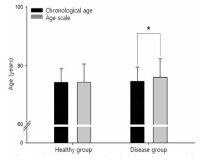
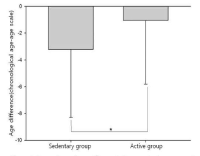
Purpose The purpose of this study was to determine the effectiveness of six-weeks intermittent hypoxic training at 3,000 m hypobaric hypoxic condition on aerobic and anaerobic exercise capacity in competitive swimmers. Methods South Korean swimmers (n=20) were randomly assigned into training at sea-level (n=10, intermittent normoxic training group; INT) and training at 526 torr corresponding to 3,000 m hypobaric hypoxic condition (n=10, intermittent hypoxic training group; IHT). The participants completed an aerobic continuous treadmill training (30 min) within 80%HRmax and anaerobic interval bicycle training (10 times; 2 min of exercise and 1 min of rest) for 30min within 90%HRmax in each environment. We compared their aerobic and anaerobic exercise capacity before and after six-weeks of training. Exercise frequency was 1 hour, 3 days per a week, and during 6 week. Results In aerobic exercise capacity, PWC at 75%HRmax, estimated VO2 max, and exercise time were increased by training in only the IHT group. Estimated VO2 at 75%HRmax was increased by training in both groups, but presented a larger increase tendency in the IHT group compared with the INT group. In anaerobic exercise capacity, peak anaerobic power and fatigue index were increased by training in only the IHT group. Blood lactate level after wingate test were decreased by training in both groups, but the IHT group have a lower blood lactate level in after training compared with the INT group. Conclusion In our study, we did not measure to various dependent variables for support to enhancement of aerobic and anaerobic exercise performance. However, these results showed that the IHT method may be effective in improvement of exercise performance in competitive swimmers who participates in a variety of events from short to long distance.

The purpose of this study was to examine competitiveness of sport product companies by brand origin in the Korean market by analyzing attribute evaluation of sport products, brand equity, and purchase intention and their causal relationship. Competitive sport brands were selected in global, Japanese, and Korean brands by a pilot survey. Then, this study selected a population participating in sports for all, elite sports, professional sports, and leisure sports and 498 effective questionnaires were secured. As a result, Korean consumers for sport products evaluated global sport brands in the highest level, Japanese sport brands in the moderate level, and Korean sport brands in the lowest level in the evaluation of attribute evaluation of sport products, brand equity, and purchase intention. Moreover, the evaluation of participating types in sports for all, elite sports, professional sports, and leisure sports showed the same result in the order of global, Japanese, and Korean sport brands. Global sport brands had a sequential causal relationship from attribute evaluation of sport products to brand equity and purchase intention and formed a consumption behavior model that attribute evaluation of sport products led to purchase intention. On the other hand, while Korean sport brands had a sequential causal relationship from attribute evaluation of sport products to brand equity and purchase intention, attribute evaluation of sport products did not lead to purchase intention. Finally, it was confirmed that global brands such as Nike and Adidas had a high market position and Korean sport consumers’ purchase behavior was determined based on information of product attributes and brand equity.

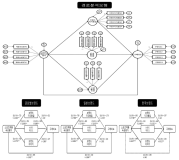
Drawing on the studies of implicit ways of teaching (Choi, 2002; Fenstermacher, 1990; Hasen, 2001; Oakeshott, 1989; van Manen, 1991), the aim of this study is to examine the educational effects of indirect teaching behavior (ITB), a new approach of researching teacher behavior, in order to better understand well-rounded education in the field of physical education. An ethnographically informed case study based on participant observation (eight months, 8th grade two co-ed physical education classes) was employed to produce a thick description of the ITB. Participant observation was supported by video recordings of classes, photos of students, questionnaires and interview, and teacher's self-report. Through inductive analysis of the data, we found that ITB had a powerful influence on forming a positive classroom atmosphere in relation to fun, active and moral. The positive atmosphere played a pivotal role in encouraging students' social and moral development including respecting their teacher, cooperating with other friends, learning the intrinsic value of physical education, and reflecting themselves. An understanding of ITB will help expand the way in which educators view teaching methods and studies in physical education beyond the dominant approach to techniques-oriented teaching in that ITB can be seen as essential content for holistic development of students. In this sense, this paper suggested that researchers and teacher educators need to re-examine the power of ITB in regard to teacher's professional competence in physical education and teacher education (PETE). For future research of ITB, it is necessary to explore what and how key personal and social-cultural factors impact teachers' ITB as is currently being conducted in the realm of teaching.
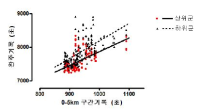
The purpose of this study was to examine that the reciprocal relationship between every 5km and full course running time record. In this study we extended our research scope to investigate whether any notable running time differences were existed among top level of marathoners. Comparisons were made using data which were drawn from 34 championship competitions had been held between year 2000 and year 2009 in Korea. Total 340 full time data was obtained from 340 marathoners who successfully completed their 42.195km running race, and divided into one of two categories, either upper ranked group (URG, ranked 1st~5th position in competitions they participated) or lower ranked group (LRG, ranked 6th~10th position in competitions they participated). Mean and standard deviation were calculated from SPSS (VER. 20.0), and repeated measures of ANOVA and Pearson's correlation was adopted to perform statistical analyses. There was no statistical difference of the running record during first 5km, however running time form all other 5km running sections was significantly faster in URG than LRG (p<.001). The gap of running time record between URG and LRG was getting more and more significant after 20km running. The quickest running record was found during 2nd 5km section (i.e., 5~10 km) and the each section's race time was getting drastically slower during 6th~7th 5km section running regardless of the study groups. Drawn conclusions from this study were that athletes use the strategy of deciding victory in both the beginning and the latter phase of marathon running. This implies that athletes who have the capacity, which make them run faster than others during the very beginning of marathon competition, and/or during 25~35km running sections would be the most preferable for the victory at the finish line.



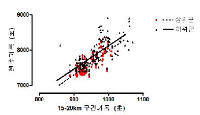




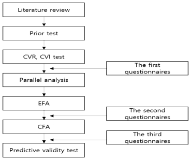
The purpose of this study was to develop an instrument that measures participantsʼ satisfaction in sports instructor training programs. The instrument development process includes focus group interviews, parallel analysis, and validity and reliability tests. Data were collected from 897 participants from three regular training sessions and were analyzed primarily using SPSS and MPlus software. The results indicated that the service satisfaction of sport instructor programs has an underlying three sub-factors, including ʻadministrative supportʼ, ʻcurriculum contentsʼ, and ʻlearning environmentʼ. This study can provide helpful information to managers in improving their respective sport instructor training programs.

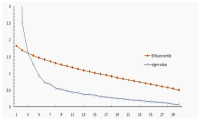

PURPOSE This study assessed Taekwondo’s impact on functional fitness and health-related quality of life (HRQoL) in older women from South Korean multicultural families. METHODS Through purposive sampling, 16 participants were divided into an experimental group that underwent a 12-week Taekwondo training program and a control group without this intervention. RESULTS Pre- and post-intervention assessments showed that the Taekwondo group experienced significant improvements in both functional fitness and HRQoL. These findings suggest that Taekwondo could be an effective physical activity for enhancing the well-being of older women in multicultural families, advocating for inclusion of culturally sensitive physical activities in health promotion programs targeting this demographic. CONCLUSIONS This study contributes to the growing body of evidence supporting physical activity’s benefits for elderly populations, particularly in multicultural family dynamics.
PURPOSE This study aimed to investigate the effects of regular moderate- and vigorous-intensity aerobic exercise on body composition, resting metabolic rate, and blood lipid profile in normal-weight obese women. METHODS The participants in the study were normal-weight obese women in their 20’s, divided into moderate- and vigorous-intensity aerobic exercise (VIAE) groups. Aerobic exercise was performed three times a week for 8 weeks. To verify the exercise effect, pre- and post- body composition, resting metabolic rate, and blood lipid profile were analyzed. RESULTS Weight and body fat decreased in both groups, and lean body mass and resting metabolic rate increased in the VIAE group. Blood TC, TG, and LDL-C decreased in both groups and HDL-C increased in the VIAE group. CONCLUSIONS In normal-weight obese women, vigorous-intensity aerobic exercise is more effective than moderate intensity aerobic exercise for improving body composition, resting metabolic rate and blood lipid profile.
PURPOSE Inclusive leadership has become increasingly important in sport organizations. Accordingly, this study examines interorganizational inclusive leadership effects on organizational trust and affiliated organizations’ employees depending on power distance. METHODS A total of 250 affiliated sport organization employees participated, and latent moderated structural equation modeling with a bifactor structural model was employed to test the hypotheses. RESULTS The results indicated that macro inclusive leadership as well as its two components significantly enhance organizational trust. Interestingly, power distance positively moderated the macro effect of interorganizational inclusive leadership on organizational trust. Lastly, organizational trust enhanced job performance and well-being, and reduced turnover intention. CONCLUSIONS The results provide meaningful insight into the relationship between lead and affiliated organizations in the context of highly competitive and collaborative sport organizations.
PURPOSE This study examined how consumers' visual attention to ads during eSports media consumption varies over time. METHODS An experimental study with a single factor, three-level within subject experimental design was conducted, utilizing an eye-tracker to measure visual attentions, including fixation count and duration. Seventy-eight students from a national university in city B participated in the experiment. A repeated measures ANOVA was conducted using the open-source statistical program R to test the research hypothesis. RESULTS Both the fixation count and duration were highest for the first ad and then gradually decreased for the second and third ad. CONCLUSIONS It is recommended that eSports sponsors should consider differentiating ad pricing based on the order of exposure, then expose the first ad presented more frequently and for extended periods, and consider different shapes, colors, and movements to prevent adaptation to the initial allocation of attention.